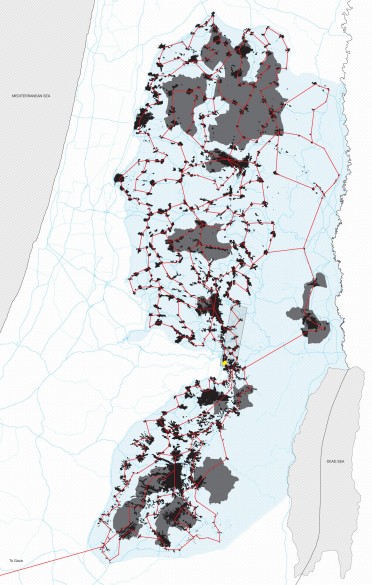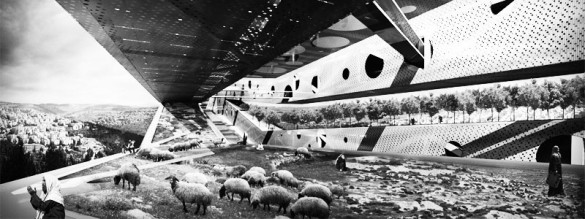With the much-vaunted month of September 2011 now behind us, and the Palestinian Authority’s statehood recognition drive presently forestalled by UN bureaucracy, perhaps it is a good time to turn our eyes back to the situation on the ground. As yet another settlement expansion receives approval, it is increasingly difficult to square the idea of a ‘sovereign’ State of Palestine with the ever shrinking enclaves of limited PA control on the ground.
Is it possible to imagine a future geography defined by the ‘pragmatic’ approach of the PA? What would be the ultimate product of a pursuit of ‘independence’ allied to an ever-deepening cooperation with the same colonial occupation that directly abrogates such a possibility?

In 2008 Viktor Ramos, then an architecture student at Rice University, offered a window into such a reality through his design thesis project. The work, entitled “The Continuous Enclave: Strategies in Bypass Urbanism”, attempted to imagine a permanent division between ‘Israel’ and ‘Palestine’ based on the Israeli logic of division and spatial fragmentation, as embedded in the Oslo Accords. Specifically, Ramos’s project takes the idea of the ‘bypass’ – synonymous with the Israeli network of settler-only roads – and begins to visualise its use as an infrastructural device to physically connect the discontinuous fragments of Palestinian ‘autonomy’. As he explains:
Extrapolating on the bypass, this thesis explores the ramifications of a continuous infrastructural network linking the fragmented landscape of Palestinian enclaves. In the process, a continuous form of urbanization has been developed to allow for the growth and expansion of the Palestinian state. Ultimately, this thesis questions the potential absurdity of partition strategies within the West Bank and Gaza Strip by attempting to realize them.(1)

One might have thought that the projection of such an ‘absurd’ vision of the future would be enough to force people to engage critically and rethink the underlying logic of separation. Yet, when Ramos’s project found its way into the blogosphere in early 2009, it was taken by-and-large at its aesthetic face value, and heralded as a “solution for Israeli-Palestinian conflict”. As the imagery became quickly divorced from its author’s own words, those who commented either scoffed at the proposal or became embroiled up in its minute details, failing to see the forest for the trees.
In correspondence with arenaofspeculation.org, Ramos explains his dismay at such a response:
I do think most people failed to understand the purpose of the project, which was not to resolve the conflict, but instead to extrapolate on the existing Oslo Accord agreements to create some version of a viable Palestinian state […] Many blogs missed this appropriation on my part of Israeli tactics and assumed that I had found some solution to the conflict through radical architecture […] I thought the dramatic images would be helpful in showing the absurdity of the situation, but in the end, I was surprised to find that people were rather confused on my stance (labelling me simultaneously pro-Israeli and pro-Palestinian).


Perhaps such a public response shows how deeply ingrained the idea of ‘two states for two peoples’ has become. The so-called ‘peace process’ reduced to a game of drawing lines on maps (and even in 3-dimensional space) to achieve a territorial ‘solution’ based on ethnic exclusivity at all costs. However, whether or not people are willing to break with this logic, Ramos’s project offers an eloquent testimony that its ultimate conclusion is a masterplan for partition that is neither pragmatic nor technically feasible in its scope.
However, for all this fetishising over the minutiae of spatial politics in Israel-Palestine – whether carving out two states or even attempting to reconcile a single political entity – there is another much larger picture which is also runs the risk of becoming obscured. Returning to the PA’s bid for ‘independence’ in the territories occupied by Israel since 1967, there are two Palestinian communities that seem to have greeted the move with most scepticism. The global diaspora of Palestinian refugees and the Palestinian citizens of Israel; the two groups whose reality today was cast for the most part in the hostilities of 1948 rather than 1967,(2) either displaced from their homes or forced to live as a disenfranchised minority within a new political order.
It is perhaps these two communities, both excluded from the mainstream media debate, that offer the perspectives required to see beyond the present political circus. Opening the possibility of a dialogue which looks simultaneously from outside-in and inside-out; building networks to transcend borders, and challenging Israeli ‘ethnocracy’ from within.

“The Continuous Enclave: Strategies in Bypass Urbanism” was first published online at Geoff Manaugh’s BLDG BLOG in February 2009. Project images featured on arenaofspeculation.org with kind permission from Viktor Ramos.
End Notes
1. Ramos’s full project description and a larger archive of images can be viewed on Flickr.
2. Obviously this is only a crude representation of the broad spectrum of opinion within the global Palestinian population. Equally, many Palestinian refugees were also displaced in the 1967 Naska (or ‘setback’).

3 replies on “After September? Strategies in Bypass Urbanism”
Hey guys,
since you included me on the twit of this article, I decided to write here a bit of what I think of this project.
You dedicated this article to the fact that Ramos has been misunderstood and that really what he wanted was to express the absurdity of the territorial consequences of the Oslo Accords. Well, I am sorry to say that I am not that surprised. I am sure that he had in his mind the glorious past of Exodus, Non Stop City and the Continuous Monument and was thinking that he could reach this perfect balance of provocation and critical narrative, it failed. We are responsible of what we create no matter why we created it. The aesthetics used here is the exact same that the numerous students in architecture are ingesting by thousand every day without ever reading a line of text, the “building” is way too detailed not to reveal a certain form of voluntarism while designing it and eventually the main perspective on the project seems to believe that it is the Israeli settlements that are prisoners from the wall in a sea of Palestinian land when we all know that it is the exact opposite that is observable in the West Bank.
So okay he had some good intentions, well next time he maybe won’t try to play a game that easily leads to cynicism if not worse, or he will spend more time studying the three paradigms of this types of projects that I quoted above in order not to fall in the same traps !
Anyway, that does not devaluate this great Arena of Speculation on which I hope to read more articles soon ! ;-)
Leopold
Leopold,
Thanks for your words. Personally, I’m in different minds about the project. You’re right to point out that the misleading image implying settlement enclaves, although the maps certainly don’t tell the same story… But I think there is a power in the bold simplicity of the idea, the attempt to harness dystopian imagery (although this was obviously lost on many), and the choice to pursue a ‘contre-projet’ approach, avoiding the trap of attempting to offer real-world ‘solutions’ (which, in my view, rarely results in an engaging or provocative design thesis).
In terms of response, Sharon Rotbard gave a glowing write-up on his blog (White Cities, Black Cities)… but you’re right that the broader response illustrates a failing that lies somewhere between the design, the explanation and the skin-deep nature of the non-specialist blogosphere (quick hits, no thoughtful debate). Nb. most of the sites featuring the project were not architectural blogs (nor Palestine/Israel blogs), which raises two things: 1) the imagery was obviously powerful enough to provoke a lay interest (which is rare); 2) Is it genuinely possible to build a complex and nuanced debate in such a forum? (ie. beyond ‘specialist’ blogs)
Anyway, it would be great to continue the discussion, perhaps in an article? I’d be really interested in your views on how your own research/design project “Weaponized Architecture” responds to these problematics, and if you have seen other projects that have successfully used architectural design to challenge the thinking of a ‘non-architectural’ audience.
Ahmad
[…] for Palestinians as a whole) went to the UN to request recognition of their statehood based on some bizarre notion of feasibility. I am of the opinion they did so knowing it would fail but as a way to take charge in (or overstep) […]